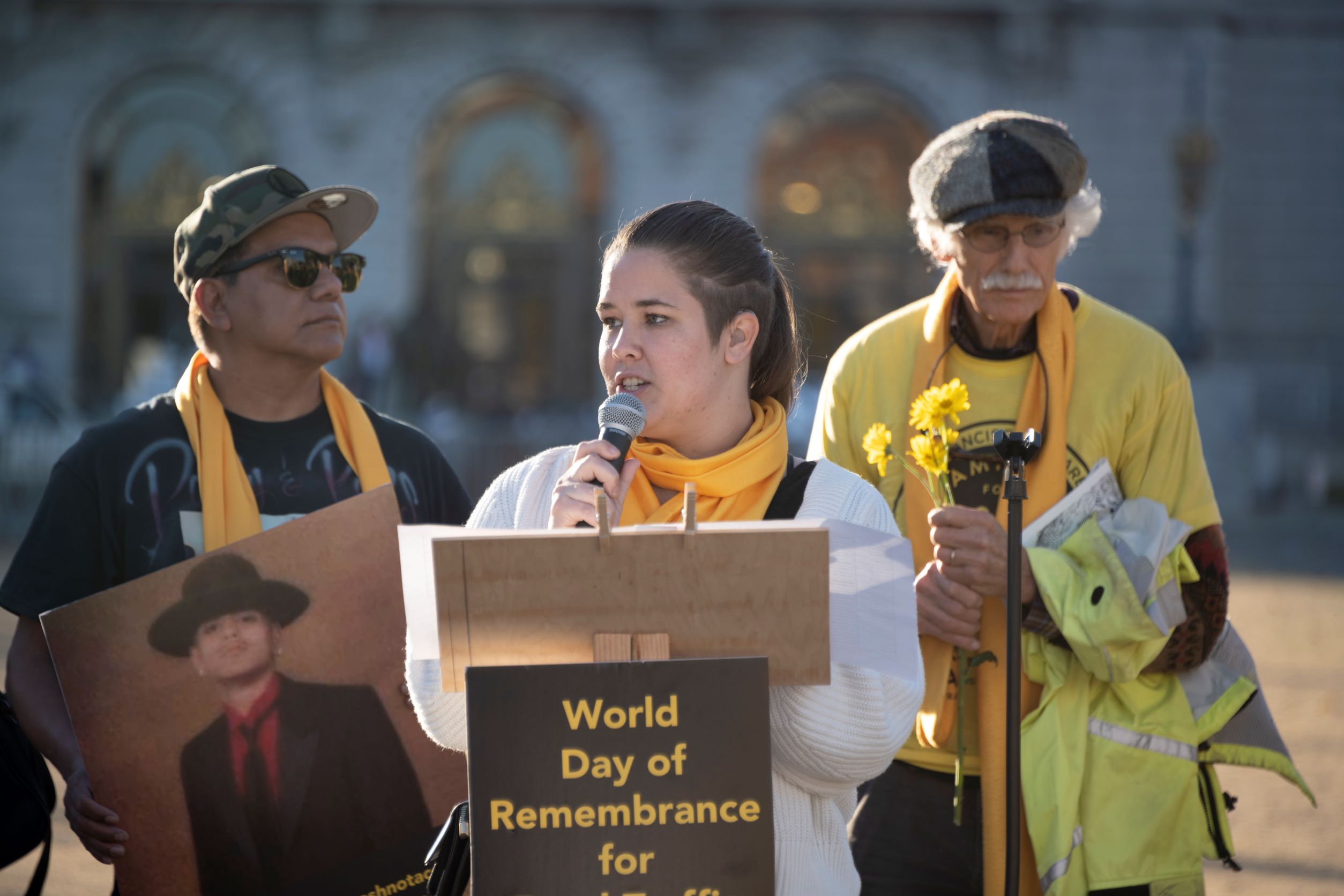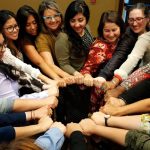
Elizabeth Colomello speaks at the World Day of Remembrance for Road Traffic Victims on November 21. Credit: William McCleod
Families and friends gathered at San Francisco’s Civic Center Plaza on November 21 to mark “World Day of Remembrance for Road Traffic Victims,” sharing personal stories and photos of loved ones to sound the alarm about speed-related crashes.
The event was an opportunity for the “power of personal stories to turn heads, cut through statistics, and really move the needle on this work,” said Aly Geller, Vision Zero engagement manager at Walk SF, which organized the San Francisco remembrance along with Bay Area Families for Safe Streets.
One of those stories came from Hannah Ege, whose husband, Sheria Musyoka, was out for a morning jog in February when he was struck and killed by a driver traveling 75 miles per hour on Lake Merced Boulevard in San Francisco. The posted speed limit near the crash site is 40 mph.
“Sheria’s life was taken in an instant,” Ege said.
Remembrance events, also observed locally in Alameda and throughout the nation, allow community members time to memorialize lives injured or lost in crashes. They also provide a forum to push for changes that prevent further deaths — especially among at-risk communities — through the support of Vision Zero.
Vision Zero is a national approach to eliminate traffic fatalities and severe injuries among all road users while increasing safe, healthy, and equitable mobility. At least 10 Bay Area cities have adopted Vision Zero policies, with San Francisco and Fremont among the first local jurisdictions to do so.
Even so, cities across the Bay Area and the United States are seeing traffic deaths increase, a sobering development due, in part, to reckless speeding, which has local city officials looking to new legislation to help slow speed limits. Meanwhile, the Metropolitan Transportation Commission (MTC) is preparing to launch a data system to assist Bay Area’s 100-plus cities in identifying and troubleshooting street safety issues.
According to the National Highway Traffic Safety Administration, U.S. traffic fatalities are up 18.4 percent in the first half of 2021. Regulators said additional data show that incidents of speeding and traveling without a seatbelt remain higher than during pre-pandemic times.
The new “phenomenon that’s taken root is reckless speeding on streets and freeways,” said Hans Larsen, public works director for the City of Fremont, which began a Vision Zero strategy in 2015. “It’s a big challenge to counteract through enforcement, education, or culture change.”
Bay Area figures speak to the seriousness of speeding. Through the end of September 2021, Fremont has seen 21 major traffic crashes, including eight fatal crashes and 13 severe injury crashes, which is above the averages from 2018 to 2020, according to the city’s Vision Zero website.
Together, reckless speeding — 25 mph or more over the posted speed limit — and crashes involving homeless individuals account for six of the eight fatal crashes in 2021. Solutions need to extend beyond street engineering and consider social and health issues related to safe housing, too, Larsen said.
About 24 traffic fatalities have occurred in San Francisco so far this year, according to San Francisco Municipal Transportation Agency (SFMTA) data as of October 31. The city experienced 29 and 27 traffic fatalities during 2020 and 2019, respectively.
City of Oakland figures show a person is severely injured or killed in a traffic crash two times a week.
Recently passed state legislation — Assembly Bill 43 (Friedman) — is viewed as one essential step toward speed reduction and crash prevention. AB 43 lets local jurisdictions set speed limits on certain roadways, chipping away at the “85th percentile rule” in which limits were determined by the speed 85 percent of drivers travel on a clear day, not by what’s necessarily safe on a particular street.
For example, near the Lake Merced crash site, the 85th percentile speed is 44 to 45 mph, above the posted speed limit of 40 mph, according to a March 9 San Francisco Examiner article about calls for safety improvements to the area.

Hannah Ege, whose husband was killed by a reckless driver on Lake Merced Boulevard, speaks to the gathered crowd. Credit: William McCleod
Now, under AB 43, “cities will be able to look at who’s using streets and design for the user versus how fast a car can go,” said Jodie Medeiros, executive director at Walk SF. “It’s the first time the state acknowledged there are different types of users, and vulnerable users should have a safer condition.”
Since AB 43 passed, SFMTA officials announced plans to reduce speed limits from 25 to 20 mph on an initial seven corridors. A second phase will include lowering speed limits on “safety corridors,” or streets with the highest number of serious injuries and fatalities. This bill feature, which takes effect in June 2024, requires the California Department of Transportation to define safety corridors in its roadway standards manual.
SFMTA’s plan aligns with strategies outlined in a recent Vision Zero action strategy that rely on quick-build programs to improve street safety faster by using paint, signs, and traffic delineator posts.
In Fremont, officials may consider lowering limits in school zones and commercial districts from 25 to 20 mph in response to AB 43, Larsen said. That would be on top of 400 safety improvement actions already made to date in school zones to encourage walking and biking to school.
Before AB 43, Fremont lowered speed limits on over 50 street segments, employing engineering changes that reorient conditions and encourage slower speeds. Changes included narrower traffic lanes and intersections, higher visibility pedestrian crossings, safety islands, and flashing beacons.
Other cities like Alameda are considering AB 43’s potential.
“We haven’t analyzed it and are looking forward to how it can affect our work because we know the safety benefits of lower speeds,” said Senior Transportation Coordinator Lisa Foster, adding the “vast majority” of Alameda streets have 25 mph speed limits.
Consider that if an individual is hit by a person driving at 20 mph, there’s a 90 percent chance of survival. When someone is hit by a car traveling at 40 mph, the chances of survival are 20 percent.
More immediately, Alameda City Council members will consider adopting its Vision Zero action plan on December 7 to eliminate traffic fatalities and severe injuries by 2035. Each year, an average of two people die, and 221 people suffer from an injury due to traffic crashes in Alameda. The council’s decision will come about a month after Alameda County Supervisor Wilma Chan was fatally struck by a car while crossing a street.
Alameda’s Vision Zero action plan is based on crash analysis and high-injury corridor maps segmented by travel mode to prioritize safety improvement locations, including the high-injury corridor where Chan was killed, Foster said. At the same meeting, the city council also will consider a new resolution related to street safety improvements in 2022 and beyond.
After a year of rising traffic fatalities, MTC plans to introduce a regional data safety system by the end of 2021. The database will be a “consistent source” for local jurisdictions to analyze potential dangers, diagnose issues, and plan tailored street design and speed management countermeasures to address them, said Shruti Hari, principal, funding policy and programs at MTC. The agency adopted a regional vision zero policy in June 2020.
The system is calibrated to integrate crash and traffic volume data, demographic information related to equity priority areas, residents’ walking and biking patterns, school, elder care, and transit locations. The data will highlight safety issues at individual intersections, as well as longer transportation corridors.
“The streets of San Francisco and every city in town should be designed to protect us, not to endanger us,” said Elizabeth Colomello, a San Francisco traffic crash victim who spoke during World Day of Remembrance last month.

Credit: William McCleod
Anyone who has experienced a traffic crash, either hit themselves or through the loss of a loved one, is encouraged to attend a Bay Area Families for Safe Streets information session on December 15 from 5 to 6 p.m.

